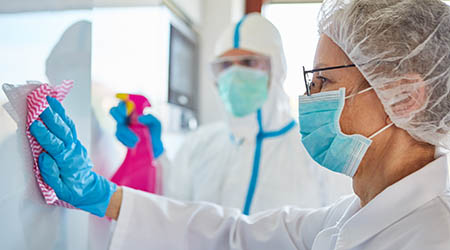Bacteria on damp and dry surfaces do not remain as isolated and free-floating life forms. They communicate and colonize with other germs to build a tough, protective biofilm that can withstand even the strongest disinfectants.
A study published in the Journal of Hospital Infection examined occurrence of dry biofilms on hospital surfaces, as well as the effect they might have on the spread of hospital-acquired infections (HAIs). Researchers assessed 61 terminally cleaned items from three hospitals in the United Kingdom and used culture-based methods and scanning electron microscopy to study the presence of dry biofilm.
They found dry biofilms to be abundant and complex. All biofilms harbored gram-positive bacteria, including pathogens associated with HAIs. Fifty-eight percent of samples grew Methicillin-resistant Staphylococcus aureus (MRSA).
“The presence of dry biofilms harboring bacterial pathogens is virtually universal on commonly used items in healthcare settings,” according to the study. “The role of dry biofilms in spreading HAIs may be underestimated. Conclusion: The risk may be further exacerbated by inefficient cleaning and disinfection practices for hospital surfaces.”
Dry-surface biofilms are widespread and can incorporate pathogens and multi-drug resistant organisms (MROs). Biofilms on highly touched surfaces pose a risk to patients because dry-surface biofilms persist for long periods, and microorganisms within biofilm have been shown to be transmitted.
Conclusion: Current cleaning practices and disinfectants are suboptimal and reinforce that MROs are incorporated into hospital surfaces’ film. Staphylococcus-aureus dry-surface biofilms are not killed by sodium hypochlorite.
Implications for infection prevention and control
Hypochlorite exposure reduced plate counts by a factor of 7 log10 and reduced biofilm biomass by a factor of 100. However, staining of residual biofilm showed that live S. aureus cells remained. On prolonged incubation, S. aureus regrew and formed biofilms. Post-exposure S. aureus isolates had MICs and MECs that were not significantly different from the parent strains. Whole-genome sequencing of one pre- and post-exposure pair found that they were virtually identical.
Conclusion: Hypochlorite exposure led to a 7-log kill, but the organisms regrew. No resistance mutations occurred, implying that hypochlorite resistance is an intrinsic property of S. aureus biofilms. The clinical significance of this warrants further study.
Transmission of Staphylococcus aureus from dry-surface biofilm via different types of gloves
Bacterial cells were readily transmitted by all three types of gloves commonly used by HCP. Surprisingly, sufficient S. aureus to cause infection were transferred from one dry-surface biofilm (DSB) touch up to 19 consecutive touches. Also, six times more bacteria were transferred by nitrile and surgical gloves than by latex gloves. Treating the DSB with 5 percent neutral detergent increased the transmission rate of DSB bacteria tenfold.
Conclusion: Staph aureus incorporated into environmental DSB and covered by extracellular polymeric substances readily contaminates gloved hands and can be transferred to another surface. These results confirm the possibility that DSB contributes to HAI acquisition.
Biofilm protects itself with a tough, thick matrix that makes up two-thirds of the film. One must break up the matrix to make the bacteria vulnerable.
Bacteria embedded in biofilms can be up to 1,000 times more resistant to disinfectants. In fact, biofilms have grown in disinfecting concentrations of quaternary disinfectants. Cleaning with surfactant-based detergents or disinfectants deposits organic residues, which some bacteria can metabolize as a nutrient source for growth in biofilms.
One of the best methods of breaking through biofilm’s matrix is agitating, brushing or scrubbing the surface to which it is attached. For difficult-to-reach areas, including nooks and crannies in a patient bed, a stiff nylon toothbrush helps break down the colonies.
J. Darrel Hicks, BA, MESRE, CHESP, Certificate of Mastery in Infection Prevention, is the past president of the Healthcare Surfaces Institute. Hicks is nationally recognized as a subject matter expert in infection prevention and control as it relates to cleaning. He is the owner and principal of Safe, Clean and Disinfected. His enterprise specializes in B2B consulting, webinar presentations, seminars and facility consulting services related to cleaning and disinfection. He can be reached at darrel@darrelhicks.com, or learn more at www.darrelhicks.com.

 UF Health Hospitals Rely on Green Globes to Realize Their Full Potential
UF Health Hospitals Rely on Green Globes to Realize Their Full Potential How Healthcare Facilities Can Be Truly Disaster-Resilient
How Healthcare Facilities Can Be Truly Disaster-Resilient TriasMD Breaks Ground on DISC Surgery Center for San Fernando Valley
TriasMD Breaks Ground on DISC Surgery Center for San Fernando Valley Bigfork Valley Hospital Falls Victim to Data Breach
Bigfork Valley Hospital Falls Victim to Data Breach AI-Driven Facilities: Strategic Planning and Cost Management
AI-Driven Facilities: Strategic Planning and Cost Management